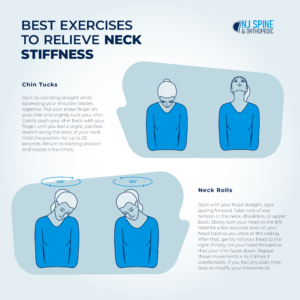Oftentimes, we don’t even realize how much we use our necks until we develop neck pain and stiffness. In many cases, neck stiffness isn’t a cause for major concern. By being mindful of our posture, personal habits, and performing neck stretches regularly, we can even avoid neck stiffness altogether.
Your neck is the bridge between your brain and the rest of your body. It houses the cervical spine allowing your brain to communicate with all your organs and body parts. In addition, the neck contains muscles and ligaments that support your head and its movements. In our modern culture of screen time and desk jobs, neck stiffness is fairly common. NJ Spine & Ortho is here to help you understand your symptoms and your treatment options.
Symptoms of Neck Stiffness
Stiff neck symptoms are pretty straightforward. Many feel an annoying soreness or shooting pain while turning their heads in a certain direction. Other times, the pain may be more intense, limiting your neck movement. This decreased range of motion often affects everyday activities. For example, if turning your head becomes painful, then driving becomes a lot more dangerous. This is because you probably aren’t checking your blind spots properly.
Since the neck connects to other areas of the body, symptoms can travel. Some people experience shoulder pain or headaches. Others experience muscle spasms in the neck and/or shoulders.
When neck stiffness symptoms don’t go away after a few days or become even worse, it may be time to consult a doctor. Other causes for concern include pain that spreads to the arms or legs and that includes numbness or muscle weakness.
Causes of Neck Stiffness
Chances are, after sleeping the wrong way or spending too much time on your favorite device, you feel a tightness while turning your head. Usually it goes away after a couple of days. However, sometimes the source of your neck pain and stiffness points to a more serious condition. Here are some common causes of neck pain:
- Muscle Strain or Sprain: In addition to prolonged screen time, repetitive or intense exercises can also be the culprit.
- Poor Posture: Hunching your shoulders while standing, walking, or sitting often weakens the neck and/or shoulder muscles.
- Injuries: A quick jolting movement to the neck often results in some stiffness. For example, whiplash from getting rear-ended in your car is a common source of neck injury.
- Excessive Stress: Stress affects the body in many different ways. Muscle tightness and rigidity in the shoulders and neck can be due to chronic stress.
- Meningitis: This condition involves the inflammation of protective membranes that cover the brain and spinal cord. Nuchal rigidity, or the inability to flex the neck forward, is a common symptom. This is a serious condition that needs immediate attention.
- Degenerative Disc Disease: A protective layer rests between each bone in the spinal column helping to absorb shock and protect the spine. When these discs become damaged, especially in the cervical spine, neck pain and stiffness occurs.
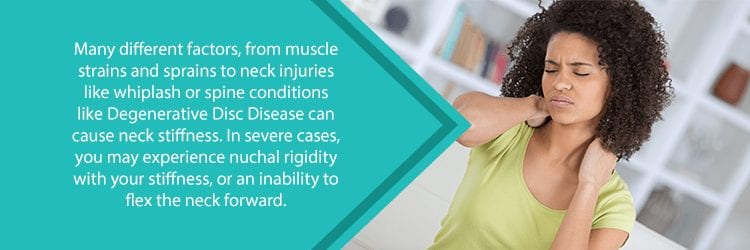
Exercises to Relieve Neck Pain and Stiffness
Here are a few simple exercises that you can perform every day to increase strength and flexibility in the neck. These exercises work best for general stiffness due to muscle strain or poor posture. If you suspect your neck stiffness is due to a more serious condition, then consult a doctor or physical therapist.
As you do these exercises, make sure you take note of any pain, tingling, and numbness. If these exercises cause the pain to get worse, then stop immediately. You don’t want to cause any further damage.
Neck Flexibility Exercises
By making the neck muscles more flexible, it increases your range of motion and reduces pressure on the spinal nerves. Do neck stretches every day and even a few times a day if it doesn’t cause any additional neck pain and stiffness.
Chin Tucks
Start by standing straight while squeezing your shoulder blades together. Put your index finger on your chin and slightly tuck your chin. Gently push your chin back with your finger until you feel a slight, painless stretch along the back of your neck. Hold the position for up to 20 seconds. Return to starting position and repeat a few times.
Neck Rolls
Start with your head straight, eyes gazing forward. Take note of any tension in the neck, shoulders, or upper back. Slowly turn your head to the left. Hold for a few seconds and roll your head back so you stare at the ceiling. After that, gently roll your head to the right. Finally, roll your head forward so that your chin faces down.
Repeat these movements 4 to 5 times if comfortable. If you feel any pain, then stop or modify your movements.
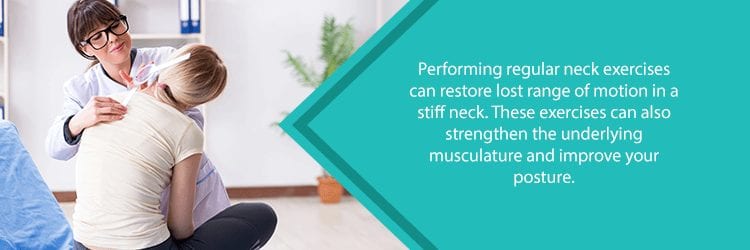
Neck Strengthening Exercises
Neck strengthening exercises help to improve and maintain your posture. They can reduce recurrent neck pain and stiffness. Perform these exercises every day or every other day to achieve best results.
Isometric Neck Exercise
Isometric exercises involve working a muscle without changing the length of the surrounding joint. Typically, this helps to maintain strength and stabilization in a muscle. The isometric neck exercise is similar to the neck rolls, but uses the hand to keep the head in place while the neck muscles contract.
Start by sitting in a chair making sure that your back is supported. Put your hand on your forehead. Push your head and neck forward as hard as is comfortable while using your hand to resist any movement. Push for about 10 seconds then relax.
Then, put your right hand on the right side of your head. Push your head towards the right for ten seconds.
Next, put a hand on the back of your head and push backwards for ten seconds.
Finally, put your left hand on the left side of your head. Push your head to the left for ten seconds while your left hand resists any movement.
Repeat these exercises three times, relaxing between each movement.
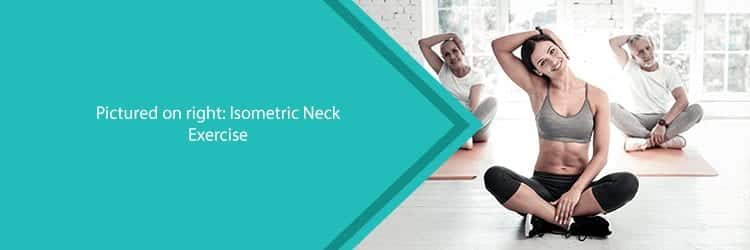
Head Lifts
Start by lying face down on a firm surface. Rest on your elbows as you raise your head, shoulders, and chest. With your chin tucked, lift your head up and back trying to look at the ceiling. Hold the position then return to looking down at the ground. Repeat at least five times.
Next, lay on your back. Raise your head off the floor while making sure that your shoulders don’t lift off the ground. Point your chin to your chest and try to stare at your stomach. Hold for five seconds and return to the lying position. Repeat up to ten times.
Get Your Shoulders Involved!
Since the shoulder and neck muscles work together to move the head, including a shoulder exercise in your daily routine can help relieve and prevent muscle stiffness.
Cross-Body Arm Stretch
Stand straight and bring your left arm across your upper chest so that your left hand rests on your right shoulder. Put your right hand on your left elbow and push the left arm towards your body. Hold for ten seconds. Switch arms and repeat the exercise.
Try to do 5 to 10 repetitions for each arm.
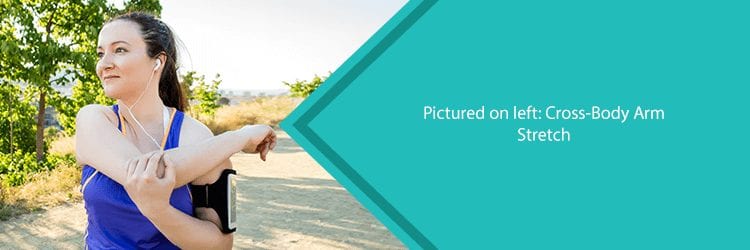
When Neck Stiffness Continues to Nag You…
In many cases, getting relief from neck stiffness requires better attention to posture, effective neck exercises, and applying hot and cold therapy to the affected area. However, some neck issues point to a more serious problem.
If your neck pain and stiffness doesn’t go away in a few days or gets progressively worse, consult a qualified physician to diagnose and treat the problem. Our experts at NJ Spine & Orthopedic will help to determine the cause of your neck pain and stiffness and recommend our most effective treatments to resolve your pain. If your neck issues require minimally invasive surgery, then our team of spinal specialists can help to relieve your pain with the shortest possible recovery time.
Don’t let neck pain keep you from enjoying your everyday life. NJ Spine & Orthopedic will help you get back to the life that you love!


